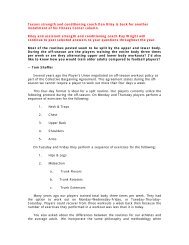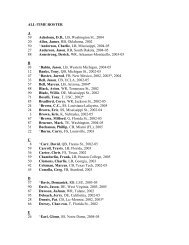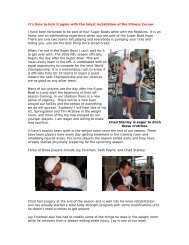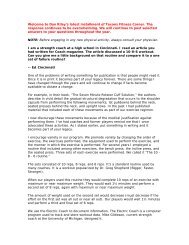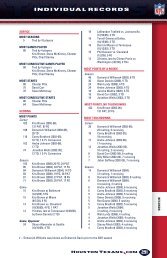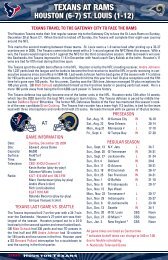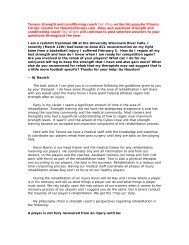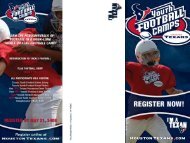HOUSTON TEXANS STRENGTH & CONDITIONING PROGRAM ...
HOUSTON TEXANS STRENGTH & CONDITIONING PROGRAM ...
HOUSTON TEXANS STRENGTH & CONDITIONING PROGRAM ...
Create successful ePaper yourself
Turn your PDF publications into a flip-book with our unique Google optimized e-Paper software.
Listed below are the techniques we emphasize to improve your start:<br />
rapidly move the down arm rearward (scrape the ground hard and fast)<br />
rapidly rotate the bent arm forward (throw fist in the direction you are running)<br />
gain as much ground as possible on your first step<br />
step forward in a straight line (the first step many players take is away from<br />
the<br />
centerline of the body)<br />
each succeeding step must be in a straight line<br />
reach the torso erect position as soon as possible (get up and out of your<br />
stance)<br />
Running Fast!<br />
Kevin McNair, a respected speed development expert, states, “You don’t get speed<br />
through the air, you get it through the ground. Speed is down hard, back, and<br />
prolonged. Everything is behind the body.”<br />
When McNair says speed is down hard, he is referring to the front leg driving down<br />
toward the ground. Once the foot touches the ground it drives rearward, propelling the<br />
body forward. The longer (prolonged) the foot stays on the ground the greater the<br />
opportunity to propel the body forward.<br />
Speed is gained from the point the foot touches the ground until it leaves. The longer<br />
it stays on the ground behind you the better. Stride length is increased behind you, not in<br />
front of you.<br />
Vertical Displacement<br />
Any vertical lift will force you to spend more time in the air, less on the ground, and<br />
slow you down. Eliminate the vertical component and you’ll increase speed.<br />
Fast runners often appear to run effortlessly. Their heads remain level once they have<br />
reached the upright position. The term we use to describe this condition is vertical<br />
displacement. Your vertical displacement can be measured while you run. It is the<br />
distance that your head moves up and down above and below your standing height. The<br />
greater the curve, the more the vertical lift. Minimize vertical lift and you’ll run faster.<br />
Listed below are tips to eliminate vertical lift:<br />
* rotate at the shoulder, do not shrug as you swing the arm forward<br />
* while rotating the arm forward keep your arm flexed at 90 degrees<br />
* while rotating the arm forward do not bring your hand higher than the sternum<br />
* while rotating your arm rearward do not bring the thumb beyond the hip<br />
* throw the knee in the direction you are running (upper leg reaches a position<br />
parallel to the ground)<br />
* do not land with your front foot beyond your hip (over striding will force you<br />
to pole vault up and over the landing leg)<br />
* keep your upper body erect (run tall), do not rock forward at the waist<br />
Rotary Forces<br />
Rotary forces that are misdirected will slow you down. One of Newton’s Laws of<br />
Motion states, “For every action there is an equal and opposite reaction.” You will<br />
compensate with an equal action on the opposite side of the body if any body part<br />
rotates away from the direct line that you are running in. This will have a negative<br />
impact on your straight-ahead speed.<br />
Anding/Riley/Wright 41



